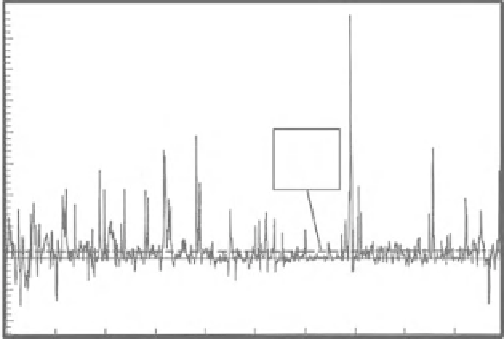Geoscience Reference
In-Depth Information
2
1
Mean
value of
(
w
q
)
Figure 15.9
Time variation
of (
0
q
v
w
) in unstable,
superadiabatic daytime
conditions. (Redrawn from
Stull, 1988, published with
permission.)
0
20
40 60
Time (seconds)
80
100
turbulent eddy that gives a negative excursion of vertical wind speed moves
a parcel of air downward that is subsequently cooler than its surroundings. In this
case the same sensor would simultaneously measure a negative fluctuation in
vertical wind speed and a negative fluctuation in temperature, and the product
(
q
v
w
) would
again
be positive. Thus, both eddies contribute positively to the time-
average value of the product (
q
v
w
) and the kinematic eddy flux of sensible heat is
positive. Hence, there is heat flow away from the surface, consistent with the fact
that it is warmer than the overlying air in the ABL.
In case (b) the situation is reversed. Positive excursions of vertical wind speed
move air upward that is subsequently cooler than its surroundings and negative
excursions of vertical wind speed move air downward that is subsequently
warmer than its surroundings. In both cases the product (
q
v
w
) is negative, so
the time-average value of the product (
q
v
w
) and the kinematic eddy flux of
sensible heat is negative. There is heat flow from the warmer air toward the
cooler surface.
The discussion just given might wrongly be interpreted as implying that vertical
excursions and associated transport are of similar magnitude and duration. But
this is not the case. Very commonly, measurements taken at a point above the
ground during the day in unstable superadiabatic conditions show strong short-
lived positive excursions in (
q
v
w
) superimposed on longer intervening periods
with (
q
v
w
) less than zero, see Fig. 15.9. Figure 15.10 shows that the frequency of
occurrence for
q
v
′
,
w
′
, and (
q
v
w
)
′
are typically skewed in such conditions for both
q
v
′
. Such
observations suggest that in this case much of the turbulent transport is occurring
via rapidly ascending 'convective plumes' which have limited extent in the
horizontal plane and therefore limited duration at a particular point. This is
confirmed by Fig. 15.11, which shows the normalized frequency distribution of
and
w
′
, but are particularly strongly skewed for the product (
q
v
w
)
′





